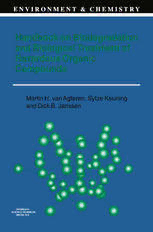
Handbook on Biodegradation and Biological Treatment of Hazardous Organic Compounds PDF
Preview Handbook on Biodegradation and Biological Treatment of Hazardous Organic Compounds
HANDBOOKON BIODEGRADATION-ANDBIOLOGICALTREATMENTOF HAZARDOUSORGANICCONWOUNDS ENVIRONMENT & CHEMISTRY VOLUME2 Thetitlespublishedinthisseriesarelistedattheendofthisvolume. Handbook on Biodegradation and Biological Treatment of Hazardous Organic Compounds by Martin H. van Agteren UniversityofGroningen, DepartmentofBiochemistry. GroningenBiomolecularSciences andBiotechnologyInstitute. FacultyofNaturalSciences. Groningen,TheNetherlands SytzeKeuning BioclearEnvironmentalBiotechnology, Groningen, TheNetherlands and DickB.Janssen University ofGroningen, DepartmentofBiochemistry, Groningen BiomolecularSciencesandBiotechnologyInstitute, FacultyofNaturalSciences, Groningen, TheNetherlands Springer-Science+BusinessMedia, B.V. A C.I.P. Catalogue record for this book is available from the Library of Congress. ISBN 978-90-481-5010-6 ISBN 978-94-015-9062-4 (eBook) DOI 10.1007/978-94-015-9062-4 Printed on acid-free paper All Rights Reserved © 1998 Springer Science+Business Media Dordrecht Originally published by Kluwer Academic Publishers in 1998. Softcover reprint of the hardcover I st edition 1998 No part of the material protected by this copyright notice may be reproduced or utilized in any form or by any means, electronic or mechanical, including photocopying, recording or by any information storage and retrieval system, without written permission from the copyright owner Contents Preface vii Chapter 1 Introduction 3 Biodegradation and biological treatment 4 - Biodegradation 4 - Aerobic degradation oforganic compounds 4 - Anaerobic degradation ofpollutants 5 - Cometabolic transformation ofpollutants 7 - Prerequisites for biodegradation and biological treatment 8 The objective of this book 9 Chapter structure and contents 10 Further reading 11 Chapter 2 Aliphatic compounds 13 2.1 Acrolein 15 2.2 Acrylonitrile 19 2.3 Diethylamine 25 2.4 Dimethylamine 29 2.5 Hydrazine 35 2.6 Ethene and ethylene oxide 39 2.7 Propylene oxide 45 2.8 Formaldehyde 51 2.9 Mineral oil 57 Summary 65 References 67 Chapter 3 Halogenated aliphatic compounds 77 3.I Chloromethanes 79 3.2 Chloroethenes 93 3.3 Chloroethanes and related compounds 111 3.4 Chloropropanes, -propenes and related compounds 127 3.5 Methyl bromide and 1,2-dibromoethane 137 3.6 Chlorofluorocarbons 143 3.7 Bis(2-chloroisopropyl)ether and related chloroethers 147 3.8 2-Chloro- and hexachloro-1,3-butadiene 151 3.9 Hexachlorocyclohexane 155 Summary 165 References 167 v Chapter 4 Aromatic compounds 189 4.1Benzene 191 4.2Benzidine 203 4.3Biphenyl 207 4.4 Ethylbenzene 213 4.5Phenol 219 4.6Isopropylbenzene 229 4.7Styrene 235 4.8Toluene 243 4.9Xylene 257 4.10 Diethylhexyl phthalate 265 Summary 271 References 273 Chapter 5 Polyaromatic hydrocarbons (PADs) 287 5.1 PAHs with two fused aromatic rings 289 5.2 PAHs with three fused aromatic rings 307 5.3PAHs with four fused aromatic rings 321 5.4 PAHs with five or more fused aromatic rings 331 Summary 339 References 341 Chapter 6 Chlorinated aromaticcompounds 351 6.1Chloroanilines 353 6.2Chlorobenzenes 363 6.3 Chlorophenols 379 6.4 Chloronitrobenzenes 405 6.5 Chloronitrotoluenes 411 6.6 Chlorotoluenes 413 6.7Chlorotoluidines 419 6.8Dichlorobenzidines 423 6.9Monochloronaphthalenes 425 6.10Polychlorinated biphenyls and terphenyls 429 6.11Chlorinated dibenzo-p-dioxins and dibenzofurans 441 Summary 449 References 451 Chapter 7 Synonyms 475 Abbreviations 481 Glossary 483 Index 489 vi Preface The introductionof syntheticorganic chemicalsintotheenvironmentduring thelastfew decades has given rise to major concern about the ecotoxicological effects and ultimate fate of these compounds. The pollutantsthat are considered to be most hazardous because of their intrinsic toxicity, high exposure level, or recalcitrant behavior in the environment have been placed on blacklists and other policy priority lists. The fate of synthetic compounds that enter the environment is mainly determined by their rate of biodegradation, which therefore also has a major effect on the degree of bioaccumulation and the risk of ecotoxicological effects. The degree and rate of biodegradation is also of critical importance for the feasibility of biological techniques to clean up contaminated sites and waste streams. The biodegradation of xenobiotics has thus been the subject of numerousstudies, which resulted in thousandsofpublicationsinscientificjournals, books, and conference proceedings. These studies led to a deeper understanding of the diversity of biodegradation processes. As a result, it has become possible to enhance the rate of degradation of recalcitrant pollutants during biological treatment and to design completely newtreatment processes. At present, much work is being done to expand the range of pollutants to which biodegradationcan be applied, and to make treatment techniquesless expensiveand better applicable for waste streams which are difficult to handle. In order to achieve these objectives, one needs information about the chemical and physical properties of the contaminants, and about the possibilities for biodegradation under a variety of environmental conditions. Insight into biodegradation processes and the physiology of the organisms involved isessential for selectingtreatment strategies. Theobjective of this book isto present informationabout thebiodegradation of a range of important synthetic chemicals. Microbial-degradation pathways are presented and the consequencesfor applicabilityintreatment systemsare discussed. The book is intendedfor use by engineers, chemists, microbiologists, toxicologists, and environmental scientists who are involved in the development, introduction, operation or evaluation of biological treatmentsystems. The figures and tablesinthebook shouldleadto a better understanding of degradation routes and indicate under which conditions specific microorganisms or consortiacanbe used to degrade a selectedcompound. Althoughabriefintroduction aboutthe generalprinciples ofbiodegradation processesis given, the text assumes that the reader has a basic knowledge of microbiology and bio degradation in general. The compilation of this book has been funded by Senter as part of the Innovative Research Programme Environmental Biotechnologyunder contract 1MB93012. We thank the members of the advisory committee Dr. Ir. J. Bovendeur, and Ir. E. Krowinkel for their helpful support throughout this project. We also acknowledge our colleaguesTjibbe Bosma, Margriet Derix, Inez Dinkla, Wim de Koning, Jeffrey Lutje Spelberg, Astrid Mars, Wouter Noordman, Ton Schoot Uiterkamp, and Johan van Hylckama Vlieg for reviewingchapters of thisbook. Martin H. vanAgteren Dick B. Janssen Sytze Keuning vii Acknowledgement Thisstudy has beensubsidisedbytheInnovationOriented Research Programme(lOP) on Environmental Biotechnology.The lOP Programme is managed by Senter. Senteris the executive agency of the Ministry of Economic Affairs that manages and implements programmes and schemes which increase thecompetitivepower of the Dutch Economy, foster internationalcooperationandpromotesustainable development. Ithasmadeitsmark particularlyinthe fieldsoftechnology,energy andenvironment. EnTEr (;)1 1 Chapter Introduction
